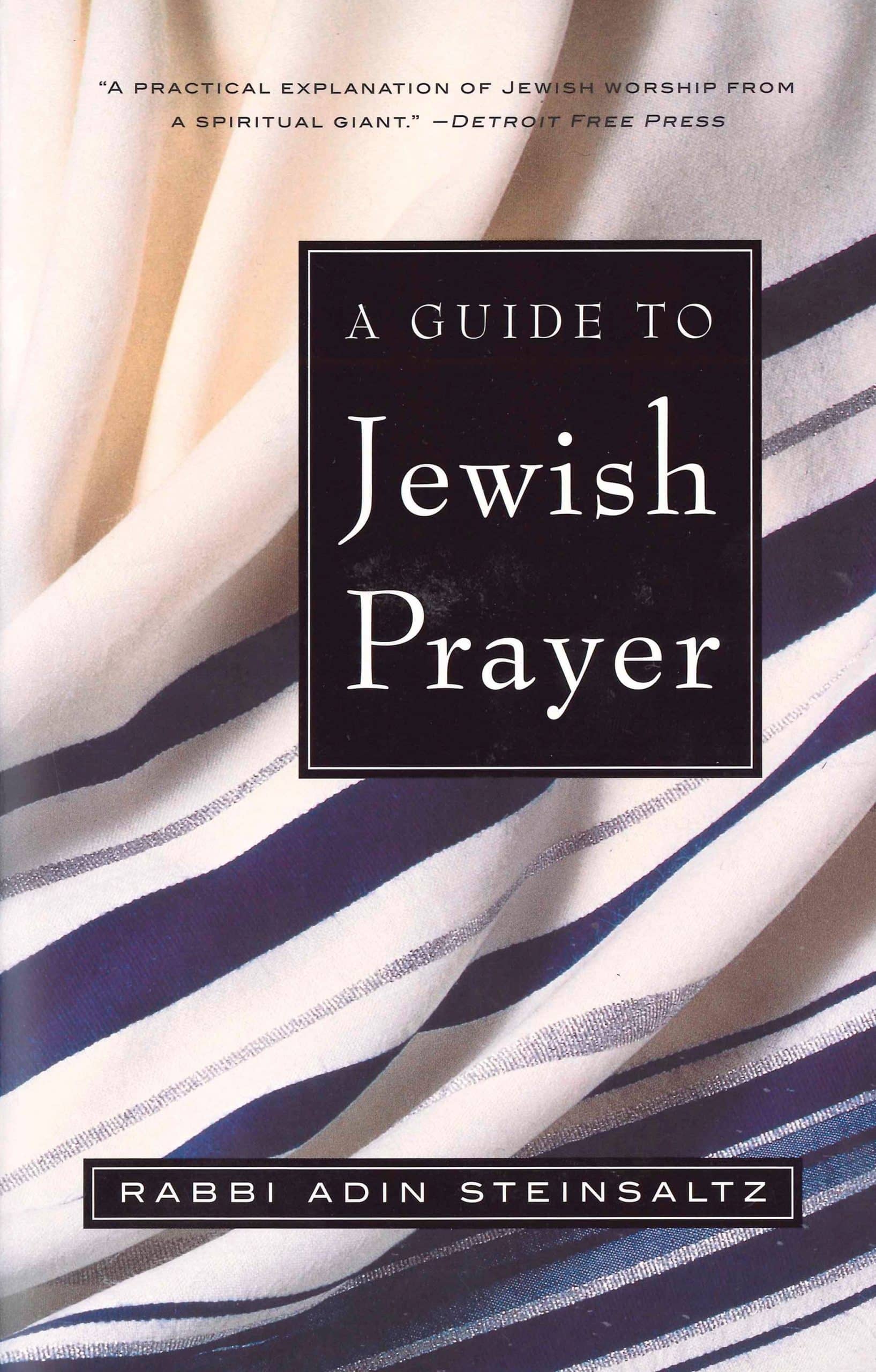A Guide to Jewish Prayer
14.00 JOD
Please allow 2 – 5 weeks for delivery of this item
Description
From one of the world’s most famous and respected rabbis—”a practical explanation of Jewish worship from a spiritual slant” (Detroit Free Press).For both the novice and for those who have been engaged in prayer for years, here is the one guide needed to practice Jewish prayer and understand the prayer book. From the origins and meaning of worship to a step-by-step explanation of the daily prayers to the reason you’re not supposed to chat with your friends during services, Rabbi Adin Steinsaltz answers many of the questions likely to arise about Jewish prayer. Here are chapters on daily prayer; Sabbath prayer; prayer services for the holidays; the yearly cycle of synagogue Bible readings; the history and makeup of the synagogue; the different prayer rites for Ashkenazim, Sephardim, Yemenites, and other cultural/geographic groupings; the role of the rabbi and the cantor in the synagogue; and the role of music in the service.
Additional information
| Weight | 0.52 kg |
|---|---|
| Dimensions | 3.13 × 13.16 × 20.25 cm |
| PubliCanadation City/Country | USA |
| by | |
| format | |
| Language | |
| Pages | 464 |
| publisher | |
| Year Published | 2002-3-5 |
| Imprint | |
| ISBN 10 | 0805211470 |
| About The Author | RABBI ADIN STEINSALTZ is the author of a landmark commentary on the Talmud, as well as many books of Jewish thought. He lives in Israel. |
"A practical explanation of Jewish worship from a spiritual slant." —Detroit Free Press"Readers familiar with Rabbi Steinsaltz's high level of descriptive prose, which appeals to people with varying levels of Jewish knowledge, will find this volume similarly of great interest." —The Jewish Week |
|
| Table Of Content | Introduction / xvii PART ONE • Prayer CHAPER 1. The Prayer Book / 3 CHAPTER 2. The Essence of Prayer / 8 CHAPTER 3. Individual and Communal Prayer / 14 The Nature of Communal Prayer / 15 The Communality of Prayer / 18 Individuality of Prayer / 19 The Meaning of Communal Prayer / 22 Individual Prayer Within Communal Prayer / 24 CHAPTER 4. Men and Women / 26 The Commandment to Pray Applies to All / 26 Differences in the Concept of Prayer / 26 Historical Causes / 28 Women’s Prayer Texts / 30 The Women’s Gallery (Ezrat Nashim) / 31 CHAPTER 5. Kavvanah / 34 The Importance of Kavvanah / 34 Levels of Kavvanah / 35 Kavvanah and the Regularity of Prayer / 38 Achieving Kavvanah / 40 PART TWO • History CHAPTER 6. The History of the Siddur / 47 The Creation of Standard Prayer Texts / 48 Prayer in Mishnaic and Talmudic Times / 51 Liturgical Poets and Devotional Poetry (Piyyut) / 53 Suddurim and Mahzorim / 57 The Influence of the Kabbalah / 58 Recent Generations / 61 CHAPTER 7. Prayer Rites / 62 Antiquity of the Prayer Rites / 63 Justification for the Different Prayer Rites / 64 Prayer Rites Today / 66 Nusaḥ Ashkenaz—The Ashkenazic Rite / 66 Nusaḥ Sepharad—The Sephardic (Hasidic) Rite / 69 The Oriental (Sephardic) Rite / 71 The Yemenite Rite / 73 The Italian Rite / 75 Extinct Prayer Rites / 77 PART THREE • The Order of Prayer Services CHAPTER 8. Weekday Prayer Services / 83 Prayer and the Life Cycle / 83 The Daily Prayers / 84 Tikkun Ḥazot / 84 The Sharḥarit Service / 86 The Minḥah Prayer / 96 The Ma’ariv (Arvit) Prayer Service / 98 Shema Upon Retiring to Bed / 101 CHAPTER 9. Shabbat / 104 The Order of the Shabbat Day / 105 Shabbat Prayer Services / 107 The Friday Minḥah Prayer / 107 Kabbalat Shabbat—The Reception of Shabbat / 107 The Shabbat Ma’ariv Service / 110 The Shaḥarit Service / 112 Torah Reading / 114 The Musaf Service / 115 The Minḥah Service / 116 The Ma’ariv Service on Motza’ei Shabbat (“The Conclusion of Shabbat”) / 118 The Departure of Shabbat / 119 The Havdalah Ceremony / 120 After the Havdalah / 123 Shabbat Meals / 124 The Kiddush of Shabbat Eve, and the First Shabbat Meal / 126 Preparations for the Kiddush / 127 Some of the Laws and Customs of the Kiddush / 128 The Second and Third Shabbat Meals / 130 Study on Shabbat Afternoon / 131 Melaveh Malkah / 132 Special Sabbaths / 133 Shabbat Mervarkhim / 133 Shabbat Rosh Ḥodesh / 134 Shabbat That Falls on Festival Days / 136 Shabbat Ḥol ha-Mo’ed / 137 Shabbat of Ḥanukkah / 139 Shabbat Rosh Ḥodesh on Ḥanukkah / 140 The Arba Parshiyyot (“Four Portions”) / 140 Shabbat on Days When Taḥanun Is Not Recited / 142 Shabbat ha-Gadol / 142 Shabbat Teshuvah (Shuvah) / 143 The Sabbaths of Evil Dispensation / 144 The Sabbaths of Comfort / 144 Other Sabbaths / 145 CHAPTER 10. Festivals / 146 Festival Days / 146 The Three Pilgrimage Festivals / 147 The Second Days in the Diaspora / 148 Festival Prayers in General / 150 The Ma’ariv Service / 150 The Shaḥarit Service / 153 Torah Readings / 153 The Musaf Service / 154 The Minḥah Service / 155 Conclusion of the Festival / 156 The Pesaḥ Festival / 156 The Beginning of the Pesaḥ Festival / 156 The Pesaḥ Seder / 157 The Shaḥarit Service / 161 The Musaf Service / 162 The Minḥah and the Ma’ariv Services / 162 The Second Day of Pesaḥ (in the Diaspora) / 162 The Seventh Day of Pesaḥ / 163 The Last Day of Pesaḥ (in the Diaspora) / 164 The Shavu’ot Festival / 165 Shavu’ot Prayer Services / 166 The Second Day of Shavu’ot (in the Diaspora) / 168 The Sukkot Festival / 168 Sukkot Prayer Services / 170 The Second Day of Sukkot (in the Diaspora) / 171 Shemini Atzeret and Simḥat Torah / 172 Shemini Atzeret (in the Diaspora) / 173 Simḥat Torah / 174 CHAPTER 11. Days of Awe / 177 Rosh ha-Shanah—The New Year Festival / 178 The Minḥah Service on Rosh ha-Shanah Eve / 180 The Ma’ariv Service / 180 Kiddush and the Festive Meal / 182 The Shaḥarit Service / 183 Torah Readings / 184 Teki’ot—The Blowing of the Shofar / 185 The Musaf Service / 188 The Minḥah Service / 192 Tashlikh / 192 The Second Day of Rosh ha-Shanah / 192 Prayer Services on the Second Day of Rosh ha-Shanah / 194 Yom Kippur—The Day of Atonement / 195 Yom Kippur Eve / 197 Kol Nidrei / 198 The Ma’ariv Service / 201 The Shaḥarit Service / 203 Torah Readings / 204 The Musaf Service / 205 The Minḥah Service / 207 The Ne’ilah Service / 208 Conclusion of the Festival / 211 CHAPTER 12. Special Days / 213 Rosh Ḥodesh—The New Moon / 213 Ḥol ha-Mo’ed—The Intermediate Days of a Festival / 217 Ḥol ha-Mo’ed of Pesaḥ / 219 Ḥol ha-Mo’ed of Sukkot / 220 Ḥosha’na Rabbah / 221 Shabbat Ḥol ha-Mo’ed / 222 Hanukkah / 222 Rosh Ḥodesh During Hanukkah / 225 Purim / 225 Shushan Purim / 227 Fast Days / 229 The Ninth of Av (Tish’ah be-Av) / 229 Memorial Fast Days / 233 The Twentieth of Sivan—A Fast Day of Remembrance / 236 Fast Days for Repentance and Atonement / 237 Other Fixed Fast Days / 239 Nonfixed Fast Day / 240 Special Time Perios / 243 The Ten Days of Repentance / 243 The Month of Nisan / 244 The Counting of the Omer / 244 The Three Weeks (Bein ha-Meitzarim) / 245 The Month of Elul / 245 Days of Joy / 246 Local Purims / 247 Lag ba-Omier—The Thirty-third Day of the Omer Period / 247 The Day of Independence and Jerusalem Day / 248 Other Days When Taḥanun Is Not Recited / 249 CHAPTER 13. Torah Readings / 253 The Cycle of Torah Readings / 254 Taking the Torah Scrolls Out of the Ark / 256 The Order of Calling Up to the Torah / 258 Blessings for the Torah / 260 Torah-Reading Customs / 263 Hagbahah (“Raising”) and Gelilah (“Winding”) of the Torah Scroll / 265 Returning the Torah Scrools to the Ark / 267 The People Called Up to the Torah Reading / 268 The Torah Scroll / 270 Wrappings and Decorations of the Torah Scroll / 274 The Pointer (Yad) / 276 Cantillation of the Torah Reading (Ta’amei he-Mikra) / 277 Emperor Accents / 279 King Accents / 279 Minister Accents / 280 PART FOUR • The Synagogue and Communal Prayer CHAPTER 14. The Synagogue / 285 Ancient Origins of the Synagogue / 285 Ancient Synagogues / 286 Synagogues Outside the City / 287 The Structure of the Synagogue / 288 The Women’s Gallery / 290 Orientation / 290 Synagogue Accessories / 292 The Holy Ark / 292 The Bimah / 292 Ner Tamid—The Eternal Light / 293 The Prayers Lectern / 293 Candles and Lamps / 294 The Basin / 294 Seating / 295 Additional Accessories / 295 Synagogue Architecture / 297 Ornamentation / 298 Small Synagogues / 300 Minyanim / 301 The Shtibel / 302 Synagogue Laws / 303 The Synagogue and the Beit Midrash (“House of Study”) / 305 Official Functions and Appointments / 306 Head of the Synagogue (Rosh ha-Knesset) / 306 Parnas / 307 Gabbai / 308 Ḥazzan—Cantor / 309 Shammash / 309 Ba’al Keriah—Torah Reader / 310 Meturgeman—Interpreter / 311 The Ten Batlanim / 312 Rabbi / 312 Other Use of the Synagogue / 313 Talmud Torah—Torah Study School for Children / 214 Communal Meetings / 315 Weddings and Circumcision Ceremonies / 316 Beit Din—Religious Court / 316 Guest House / 317 CHAPTER 15. The Shaliaḥ Tzibbur / 318 The Role of the Shaliaḥ Tzibbur and Its Origins / 318 The Ḥazzan / 319 The Shaliaḥ Tzibbur as Emissary to God / 321 Various Demands on the Shaliaḥ Tzibbur / 324 The Choir / 325 Ḥazzan versus Ba’al Tefillah / 328 The Kavvanah of the Shaliaḥ Tzibbur / 329 CHAPTER 16. Prayer Accessories / 332 Prayer Garments / 332 Head Coverings / 333 The Tallit / 336 When and by Whom the Tallit Is to Be Worn / 337 Significance of the Tallit and Its Blessing / 339 The Tzitzit / 341 Laws and Customs of the Tzitzit / 342 Making the Tzitzit / 344 Making the Tallit / 346 The Tallit Band (Atarah) / 347 The Tallit Bag / 348 The Blue Thread (Tekhelet) / 348 Tefillin / 349 Making the Tefillin / 351 The Content of the Commandment of Tefillin / 354 The Manner of Donning Tefillin / 358 Blessings and Recitations / 361 Tefillin of Rabbenu Tam / 363 Some Laws and Customs of Tefillin / 363 The Prayer Sash / 365 Hand-Held Objects / 366 The Siddur / 367 The Arba’ah Minim (“Four Species”) / 368 CHAPTER 17. The Music of Prayer / 370 Music and Prayer / 370 Music in the Temple / 370 The Loss of Ancient Music / 372 Evolution of Prayer Music / 373 Melodies of Oriental Congregations / 374 Ashkenazic Cantorial Music / 376 New Melodies / 378 Styles of Prayer Music / 381 Musical Expression in Prayer / 382 Appendices Glossary of Terms / 387 Biographies / 410 Bibliographical Notes / 415 The Jewish Months and the Festivals and Special Days That Occur in Each of Them / 419 Index / 420 |
| Excerpt From Book | CHAPTER TWOThe Essence of Prayer Prayer is the salient expression of religious emotion in man and of his relationship with his Creator. There are, of course, many other forms by which people may express their religious feelings—from those fixed ceremonial rites that in themselves constitute a religious ritual, to those acts which man performs in order to obey the will of God, or from which he may refrain because they negate the Creator’s will and command. While these aspects are to be found in every person possessing religious feeling, they are to be found even more so in the Jew, whose life is filled with positive and negative commandments, traditions and customs, and Jewish ways of expression and thought. Yet there are various influences that are prone to obscure or conceal the inherent purpose of those acts that a person might perform in order to express a relationship with God. Habit and routine may cause a person to cease being aware of the reason for the performance of a given action. It often happens that a person living in a society that shares his faith and behaves in a similar fashion will perform these acts because they seem the normal mode of behavior, without attention to their actual content. Even when a person performs a ritual ceremony, there is no assurance that the meaning of this performance will be fully realized, as every act involves an external, technical aspect. By punctilious insistence upon performing it in a precise and particular manner, and in assuring that all the objects required are in proper condition, a person is liable to forget its main purpose. By contrast, prayer is a direct and unequivocal act of relating to God. In whatever way it is performed, and in whatever manner it is uttered, prayer is essentially one thing: an explicit addressing by the human “I” to the Divine “Thou.” In the most essential sense, prayer is direct speech, in which man confronts and addresses his Creator. Such speech may be of many kinds: request, supplication, thanksgiving, complaint, or even simple conversation. All these can be found in prayer, and each one of them can be expressed by personal, individual prayer. The prayers that may be found in the books of the Bible—particularly in the Book of Psalms, which is basically a compendium of individual and public prayers—represent all of the kinds and varieties of prayer with which the individual or public may address God the Creator. The wide range of prayers and benedictions found in the Siddur likewise include the entire spectrum of ways in which a man may address his Maker. Many prayers are requests or pleas in which man addresses God and asks for something—be it life, health, or success, deliverance from disaster or from poverty. Man may appeal on behalf of himself or for others, whether near and dear or distant acquaintances. On the other hand, there may be requests of an entirely different sort, in which a person asks God to consider the shame he had suffered, or voices his desire to be avenged, to have his enemies punished. There are still other prayers that are a way of saying “Thank you,” whether in general—for all the good things in life, or for the existence of something beautiful or pleasurable—or for some personal, private matter—recovery from illness, deliverance from danger, or in acknowledgement of some special event. On the other hand, there may be prayer that is an expression of questioning, of wonder, or even of complaint, such as the bold words of criticism uttered by Abraham: “Far be it from You to do so, to slay the righteous with the wicked. . . . Shall not the Judge of all the earth do right?” (Genesis 18:25); or the complaint that also indicated supplication and submission: “Righteous are You, O Lord, when I complain to You; yet I would plead my case before You. Wherefore does the way of the wicked prosper?” (Jeremiah 12:1). There are yet other prayers that have no clear, definite form of address, but are merely a kind of conversation or outpouring of the heart before God. At times, this confession is a declaration of love and yearning such as “My soul thirsts for You, my flesh longs for You” (Psalm 63:1); at others, it expresses a sense of distance in which the person bares his heart before God, asking nothing, yet expressing his grief at his material or spiritual loss. On yet other occasions, a person may wish to “tell” God about his good deeds, and to say with a sense of satisfaction, “Remember this, O my Lord, for my good” (Nehemiah 5:19), or may wish to confess his sins, both overt and covert. All these types, and many others, may be expressed in personal prayer, and are thus to be found in the Siddur, formulated as it is or both personal and public use. This aspect of prayer—of direct speech addressed to God—is essentially very intimate in character. Not only when a person is alone in the darkness of night, pouring out heart and soul, but even when standing in the midst of a large congregation, with everyone reciting the same words aloud, a close, intimate relationship with God is being expressed. This address in the form of conversation, of direct speech of the human “I” to the Divine “Thou,” even when expressed by the entire congregation, is based on the simple assumption that such dialogue is possible. But whether plea or praise, prayer is always speech addressed to God, and such speech is only possible when a person knows that “Verily God has heard me and attended to the voice of my prayer” (Psalm 66:19). This realization that “You hear the prayer of every mouth” is what directs man to pray and to confide in God all those secret, personal matters—needs, anxieties, requests, and heartfelt desires. But in order to pray in this manner, to “pour out his complaint before the Lord” (Psalm 102:1), one needs to feel a sense of intimate closeness to God, as “Our Merciful Father.” The child standing before his father feels he can tell him everything in his heart: to plead, to complain, to thank, or to simply tell him about things. At every such moment of baring the heart, in times of distress or joy, prayer takes place with the same feeling of affinity as that reflected in one of the Piyyutim recited during the Days of Awe, “For we are Your sons, and you are our Father” or, in a more profound and even mystical manner, “We are Your beloved and You our Lover.” But in contrast to this approach to prayer, there is another aspect, deriving from a totally different point of view. There is a different mode of relationship to God—that expressed by the prophet: “For who is this that has ventured to approach Me, says the Lord” (Jeremiah 30:21); or, expressed differently, “For I am a great King, says the Lord of Hosts, and My Name is awesome before the nations” Malachi 1:14). This sense of awed reverence, of standing before the exalted Divinity, is rooted in the recognition of the distance separating Man from God, As Maimonides says, “When he [i.e. man] considers such matters as they really are, he immediately retreats in fear, knowing he is a small, lowly creature standing light-mindedly before the Omniscient God.” Once a person adopts such a point of view, intimate conversation is impossible, and prayer acquires an entirely different character. Confronted by “the Great King,” one can only offer the rituals of sacred service. That is, given such a conception, prayer itself is no longer a spontaneous form of speech, but becomes a kind of ritual sacrificial act. When prayer assumes this aspect of holy service, each part fulfills a particular function in the ritual, and every word fits into its context in a precise and specified manner. This ritual requires that one wear special clothing, and every movement of the body has its own meaning and significance. Prayer then becomes a kind of royal audience, composed entirely of ceremonial grandeur, each word and phrase having its specific place within the ceremony. Such a ceremony may be held in the “Royal Temple,” a site symbolizing the dwelling place of the King of the Universe. Yet by the same token it may be held anywhere, as there is no single “place” for the Omnipresent God, and hence no need for any special building. Unlike prayer, the “temple” or “palace” has a physical reality—but in essence entry to them is identical. When praying, one is as if standing at the gates of a spiritual temple, and every step is taken—in the spiritual sense—is a passage from one chamber into another, until one ultimately stands before the Presence of the Almighty. Such a feeling is not one of fear, but essentially of awe, of the sense of standing before the sublime, “For God is in heaven and you upon earth, therefore let your words be few” (Ecclesiastes 5:1). The emphasis here is not on the fewness of one’s words, but on the consciousness of the qualitative distance between Man and God. When such a realization occurs, man cannot simply say whatever he pleases. Every word uttered must be weighted and counted, and every gesture must be considered and measured. Such feelings need not imply fear or melancholy, on the contrary: they are always accompanied by a sense of privilege that “the King has brought me into His chambers” (Song of Songs 1:4). But in any event, and whatever the content of prayer, it is always a ceremonial occasion, of worship and ritual. Both these conceptions—God as father, close and intimate, and God as exalted and majestic Being—which seem to be at opposing poles or religious experience, are united in the world of Judaism. Indeed, their combined presence is in itself a fundamental principle in the Jewish worldview. As the poet says, “Further than any distance and nearer than any nearness,” or, “Wherever I find You, You are concealed and evanescent, and wherever I do not find You, Your Glory fills the earth.” This dual conception, known in philosophy as the combination of the transcendental and immanent view of the Divine, and referred to in the Kabbalah as the tension between the aspects of God as “surrounding all worlds: and “permeating all worlds,” is an essential element of the inner truth of Judaism, and constitutes a central issue in every work of Jewish thought. Any examination of Jewish faith relates to this issue, either directly or indirectly. The kabbalistic appellation of God—“the Infinite, blesses be He”—in itself reflects this double aspect of the Divine, combining an abstract, distancing term alongside one of nearness and human concern. But such ideas are not confined to the theoretical concerns of usages and philosophers, but are expressed in the very nature of prayer itself. In fact, prayer can only be understood as combining both of these conceptions. Already in one of the most ancient prayers, we find the opening phrase conveying this attitude, “Our Father, Our King” (Avinu Malkenu). The inner tension of our relationship toward the Creator—“whether as sons or as servants”—runs through the entire order of prayer services. Sometimes one prayer may express the sense of standing before an exalted Being, while the very next prayer may be a petulant complaint uttered in extreme intimacy. Sometimes the formulation of one benediction, such as that of Hashkivenu in the Sephardic rite, may delicately interweave both conceptions, “Lay us down, our Father, to sleep . . . and raise us up, O King, to life and to peace.” When a person goes to sleep, it is as if he reposes in the arms of his Father, while when he arises from bed he is ready to serve and obey the King, his Master. These two formulations also find expression in the rabbinic dispute as to whether “Prayer was instituted by the Patriarchs” or “Prayer was instituted corresponding to the sacrifices” (Berakhot 26b). This inner tension is also reflected in the prayers of various communities and congregations: some tend to stress the ritualistic aspect, while in others, the more personal, private element is predominant. Yet everywhere and for everyone, both aspects always coexist. This dial view is essentially based on the very mystery that surrounds our attitude, understanding, and perception of the Master of the Universe (Adon Olan), who is at the same time “the Merciful Father” (Av ha-Rahaman). Our Siddur encompasses and combines together both these appellations of God as a whole, thereby allowing us to alternate in word and thought from one conception to the other. |
Only logged in customers who have purchased this product may leave a review.






Reviews
There are no reviews yet.